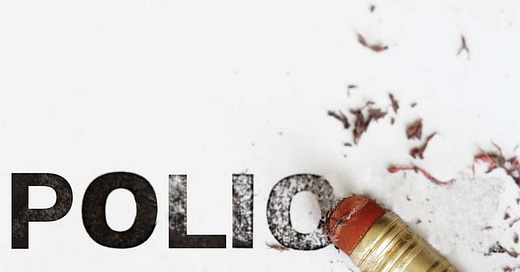How the medical authorities create the illusion of polio eradication
Is India actually 'polio free'?
The medical establishment claims that polio is close to being eradicated due to the vaccination program; as indicated by a 2016 CDC web page entitled Updates on CDC’s Polio Eradication Efforts:
“Polio incidence has dropped more than 99 percent since the launch of global polio eradication efforts in 1988.”
This claim is highly questionable, because there are large incidences of paralysis in a number of countries around the world.
One country in which this problem exists is India, where cases of paralysis are still high, despite the claim that the country is ‘polio-free:’
“Furthermore, while India has been polio-free for a year, there has been a huge increase in non-polio acute flaccid paralysis (NPAFP). In 2011, there were an extra 47,500 new cases of NPAFP. Clinically indistinguishable from polio paralysis but twice as deadly, the incidence of NPAFP was directly proportional to doses of oral polio received.”
Albert Sabin, the inventor of the polio vaccine, stated in 1951:
“The goal of poliomyelitis research is not the elimination of poliomyelitis infection but of the paralysis which is the important consequence of that infection.”
The WHO seem to have set themselves the opposite target, even if the cost is increasing paralysis.
A 2013 article entitled Polio free does not mean paralysis free was published in the widely circulated newspaper The Hindu:
“No child in India has been diagnosed with polio for nearly two years now and all the indications are that the virus responsible for it is no longer circulating here. However, the country’s polio surveillance system has indicated a sharp increase during recent years in the number of non-polio AFP cases.”
The Indian magazine Down To Earth featured an article entitled India’s polio-free status a cruel joke in 2014:
“The definition of polio has been changed repeatedly since the programme was launched, thus automatically leading to a drastic fall in the number of cases”
[…]
“Polio, traditionally synonymous with paralysis and disability, has been given a new name in India. It is now known as NPAFP or non polio acute flaccid paralysis.”
[…]
“Activist and physician Anant Phadke and C Sathyamala, epidemiologist who has been working on community health projects in different parts of the country for over 20 years, argued that it is not possible to eradicate polio, a disease primarily of poor sanitation and nutrition, with a vaccine. Polio-like paralysis can also be caused by other factors. DDT and other pesticides, exposure to lead and arsenic, other neurotoxins, injections, and vaccinations can trigger paralysis. Thus a holistic approach was needed to tackle the disease.”
[…]
“India’s polio surveillance shows that the country is polio-free. But it also indicates that the country now has the world’s highest rate of non-polio AFP cases.”
These cases of paralysis in India do not however represent a new condition, especially as acute flaccid paralysis is described as clinically indistinguishable from polio. It would seem, therefore, that the ‘new’ condition referred to as acute flaccid paralysis is, in reality, purely a name change used for cases that would previously have been diagnosed as polio.
The medical authorities have been changing diagnostic procedures in order to create a deceptive result of their polio eradication efforts:
“The number of polio cases in India was 13,000-38,000 per annum during the 1980s; currently, polio cases have dramatically declined. This reduction is incorrectly being attributed to polio vaccination only; however, the reasons for the reduction in the incidence of polio include the following: (1) Change in the diagnostic criteria: (a) Up to 1996 all reported cases of acute flaccid paralysis (AFP) were labelled as polio cases, but no follow up was done. (b) From 1997 onwards, an AFP case has been labelled as polio in the presence of one or more of the following: (i) wild polio virus detected in stool sample, (ii) residual paralysis observed after a period of 60 days of onset of paralysis, (iii) the patient has died, or (iv) the patient is lost to follow up. For example there were 10,408 and 9,587 reported AFP cases during 1990 and 1999, respectively. In 1990 all 10,408 cases (100 per cent) were labelled as polio cases, but in 1999 only 2,817 cases (29 per cent) were labelled as polio cases.”
CDC acknowledges the definition of polio cases in India pre-1997:
“All polio cases reported before 1997 were confirmed by attending physicians with no standard case definition.”








Good stuff! To add insult to injury, VAERS deleted 65 Polio vax deaths in a single update on last publication of 2009. There was over 3,500 VAERS reports on this single update see here: https://www.vaersaware.com/deleted-reports-2007-2022
Creator of Medalerts.org Dr. Steven Ruben calls it, "the great purge of 2009". I even asked Dr. McCullough myself if he knew about theses 65 IPV deleted deaths... Mr. M. said, he was aware of VAERS instabilities. I take that to mean "NO" he didn't know, but knows VAERS has issues... here is that video proof: https://www.bitchute.com/video/b2trIJRFE7ms/
Here is video proof of the 65 IPV deleted deaths: https://www.bitchute.com/video/oXvG5U5g2Aj9/
The polio vax deaths alone should have qualified that vax to be pulled off the shelf long ago, decades ago! CDC/FDA runs cover for big pharma and actually curates what we are allowed to see in VAERS... I now now better than anybody with respects to VAERS. vaersaware.com is the best!
I regret that, not having enough income to get by on and not doing anything financial online anyway, I can't send money, only appreciation for the essential information you provide. THANK YOU!